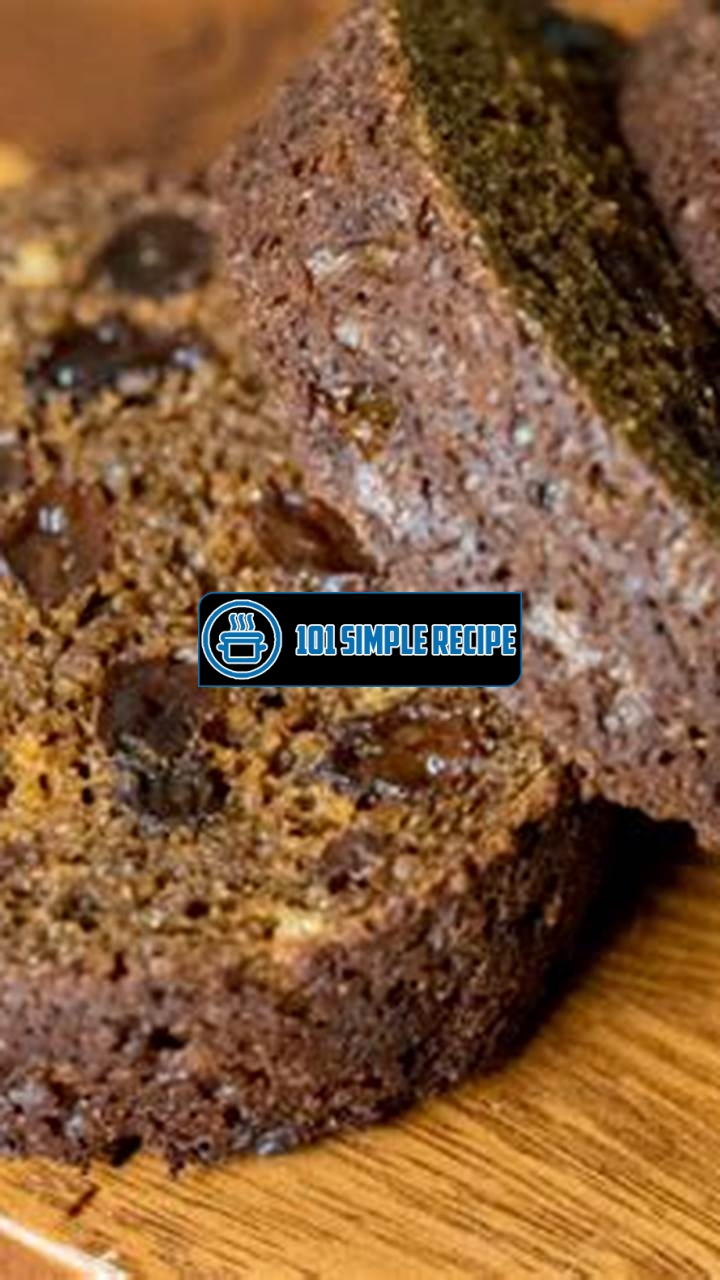Are you tired of the same old bread options and craving something unique and flavorful? Look no further! We have the perfect recipe for you: an authentic Boston Brown Bread. This traditional New England staple is made with a combination of rye flour, cornmeal, and molasses, resulting in a rich and moist loaf that pairs perfectly with your favorite spreads. In this article, we will guide you through the step-by-step process of creating this delicious treat, so you can impress your family and friends with your baking skills. Get ready to embark on a culinary adventure and bring a taste of Boston into your kitchen!

Exploring the Origin of Boston Brown Bread
Discover the rich history and cultural significance of the traditional Boston brown bread.
The Historical Background of Boston Brown Bread
Boston brown bread is a beloved staple of New England cuisine and holds a special place in the hearts of its residents. This dark, moist, and slightly sweet bread is typically made with a combination of cornmeal, rye flour, and whole wheat flour, along with molasses and buttermilk. Its unique flavor and texture make it a favorite among locals and visitors alike.
The history of Boston brown bread dates back to the early 17th century when the Pilgrims settled in the New England region. At that time, wheat was not readily available, so they had to rely on alternative grains like corn and rye to make their bread. The combination of these grains, along with the addition of molasses for sweetness, resulted in what is now known as Boston brown bread.
During the 19th century, Boston brown bread gained popularity due to its affordability and accessibility. It became a staple in many households, especially among the working class. The bread was often steamed in pudding molds or baked in tin cans, giving it its characteristic round shape.
Fun Fact: The tradition of steaming Boston brown bread in cans originated from the practice of utilizing empty food cans, something readily available in most kitchens at the time.
Over the years, Boston brown bread has remained a beloved part of New England cuisine, showcasing its enduring cultural significance. It is frequently served alongside traditional dishes such as baked beans, ham, or clam chowder. Its dense and hearty texture makes it the perfect accompaniment to these savory dishes.
Boston Brown Bread: A Staple of New England Cuisine
As you explore the culinary landscape of New England, you will quickly discover that Boston brown bread holds a special place in the region’s cuisine. Whether you visit a local bakery, dine in a charming inn, or attend a traditional New England feast, Boston brown bread is likely to grace your plate.
Boston brown bread is not only delicious but also a symbol of New England’s rich history and cultural heritage. The bread’s hearty ingredients and distinctive flavor reflect the resourcefulness and ingenuity of early settlers who had to make do with what was available to them.
Today, Boston brown bread continues to be cherished for its unique taste and the nostalgia it evokes. Many New England families have cherished recipes that have been passed down through generations, maintaining the tradition of making this beloved bread at home.
The Ingredients that Define Boston Brown Bread
The distinct flavor and texture of Boston brown bread are attributed to its key ingredients. These ingredients not only contribute to its unique taste but also lend it its characteristic dark color.
The main ingredients in Boston brown bread include cornmeal, rye flour, whole wheat flour, molasses, and buttermilk. The combination of these ingredients creates a robust and slightly sweet flavor profile that distinguishes it from other bread varieties.
- Cornmeal: Adds a slightly gritty texture and subtly sweet flavor to the bread.
- Rye Flour: Provides a nutty flavor and contributes to the dense texture of the bread.
- Whole Wheat Flour: Adds additional depth of flavor and contributes to the bread’s nutritional content.
- Molasses: Gives the bread its signature dark color and imparts a rich sweetness.
- Buttermilk: Adds moisture and tanginess to the bread, enhancing its overall taste and texture.
Note: Some variations of Boston brown bread may include additional ingredients such as raisins, nuts, or spices for added flavor and texture.
By combining these ingredients and following a traditional recipe, you can recreate the authentic taste of Boston brown bread in your own kitchen.
The Art of Making Boston Brown Bread
Master the process of creating the perfect loaf of moist and flavorful Boston brown bread. In this article, we will guide you through the steps of mixing and combining the key ingredients, choosing the right cooking method, and provide baking and serving tips for optimal enjoyment.
Mixing and Combining the Key Ingredients
Mixing and combining the key ingredients is essential in creating an authentic Boston brown bread. To achieve the perfect texture and taste, follow these steps:
- Start by gathering the ingredients: cornmeal, whole wheat flour, rye flour, molasses, buttermilk, raisins (optional), baking soda, and salt.
- In a large mixing bowl, combine the cornmeal, whole wheat flour, rye flour, baking soda, and salt. Mix well to ensure all the dry ingredients are evenly distributed.
- In a separate bowl, whisk together the molasses and buttermilk until well-blended. This mixture will provide moisture and sweetness to the bread.
- Add the molasses and buttermilk mixture to the dry ingredients. Stir until all the ingredients are fully incorporated. If desired, add raisins for extra flavor.
- Once the batter is well mixed, let it sit for a few minutes. This will allow the flours to absorb the liquid and result in a moist loaf.
Emoji: Mix all the ingredients together to create a flavorful and moist batter.
Choosing the Right Cooking Method
The cooking method you choose can greatly impact the taste and texture of your Boston brown bread. Here are a few options to consider:
- Traditional Steaming: This method involves cooking the bread in a tightly covered pot or steamer for several hours. Steaming helps to produce a moist and dense loaf of bread.
- Oven Baking: If you prefer a slightly drier and crustier bread, you can bake the batter in a loaf pan in the oven. This method results in a lighter texture and a golden-brown crust.
Emoji: Choose your preferred cooking method based on the texture and crustiness you desire.
Baking and Serving Tips for Optimal Enjoyment
Once your Boston brown bread is ready, follow these tips for the best baking and serving experience:
- Preheat your oven or steamer properly to ensure even cooking.
- For oven baking, place the loaf pan on the middle rack for consistent heat distribution.
- When steaming, make sure the water in the pot doesn’t run dry during the cooking process.
- Cool the bread in the pan for a few minutes before transferring it to a wire rack to avoid breaking.
- For serving, slice the bread while it’s still warm and serve with butter or cream cheese.
Note: The flavors of Boston brown bread enhance when served warm and spread with your favorite topping.
Emoji: Follow these tips to enjoy a warm and delicious slice of Boston brown bread.
By mastering the art of making Boston brown bread, you can create a delightful loaf with rich flavors and a moist texture. Combine the key ingredients, choose your preferred cooking method, and follow the baking and serving tips for a truly enjoyable experience. Whether you prefer the traditional steaming method or the oven baking approach, you can savor this classic New England treat. So, put on your chef’s hat, gather the ingredients, and immerse yourself in the process of making this authentic bread.
Adding a Twist: Variations on the Classic Recipe
When it comes to Boston brown bread, there’s no denying the appeal of the traditional recipe. However, for those looking to add a unique touch and elevate this classic dish, there are plenty of creative adaptations and unique ingredients to consider. By exploring different variations, you can discover exciting flavor combinations that will impress your taste buds and wow dinner guests. Let’s dive into some options that will take your Boston brown bread to the next level.
Sweet and Savory Flavor Enhancements
To add a twist to the classic Boston brown bread recipe, consider incorporating sweet and savory flavor enhancements. One delicious option is to mix in dried fruits such as raisins or cranberries to add a burst of sweetness. These fruity additions not only provide a pleasant texture but also infuse the bread with a hint of natural sweetness.
On the savory side, you can experiment with savory mix-ins like chopped olives, sun-dried tomatoes, or even diced bacon. These ingredients add depth and complexity to the flavor profile of the bread, creating a delightful contrast to its characteristic sweetness. Don’t be afraid to get creative and mix and match different flavor combinations to find your perfect blend.
Gluten-Free and Vegan Alternatives
If you or someone you know follows a gluten-free or vegan diet, fear not! There are options available to ensure everyone can enjoy the goodness of Boston brown bread. For a gluten-free alternative, replace the traditional wheat flour with a gluten-free flour blend. You can find pre-mixed blends at your local grocery store or make your own using grains like rice, tapioca, and buckwheat.
For those following a vegan lifestyle, substitute plant-based milk and butter in the recipe. Almond milk, soy milk, or oat milk can be used as a substitute for dairy milk, while coconut oil or vegan butter works well as a replacement for butter or margarine. These swaps ensure that your Boston brown bread remains moist and flavorful, without sacrificing its traditional taste.
Exploring Regional Takes on the Recipe
Boston brown bread has been enjoyed not only in Boston but also in various regions across the United States, each with its own unique take on the recipe. By exploring these regional adaptations, you can discover new flavors and techniques that may surprise and delight your palate.
For example, New Englanders often include molasses as a key ingredient, which gives the bread its distinct flavor and rich brown color. In the Midwestern region, cornmeal is sometimes added to the recipe, adding a subtle sweetness and slightly gritty texture. And in the Southern states, a touch of buttermilk is commonly used, lending a tangy flavor and tender crumb.
By exploring these regional takes on Boston brown bread, you can learn more about the cultural and culinary diversity of this treasured dish.
In conclusion, there are numerous ways to add a twist to the classic Boston brown bread recipe. Whether it’s incorporating sweet and savory flavors, accommodating dietary restrictions with gluten-free and vegan alternatives, or exploring regional variations, these adaptations will undoubtedly enhance your dining experience. Don’t be afraid to experiment and make the recipe your own, and prepare to impress with your elevated version of the beloved Boston brown bread.
If you’re looking for a delicious homemade bread recipe, try this Boston Brown Bread recipe. It’s a classic New England favorite that is perfect for breakfast or brunch. The rich, molasses flavor and hearty texture make it a real treat.
Serving Suggestions: Pairing Boston Brown Bread with Delightful Combinations
When it comes to enjoying a delicious slice of Boston brown bread, the key is finding the perfect accompaniments and pairings. From homemade spreads to delectable toppings, there are countless options to enhance the flavors and textures of this classic treat. Whether you prefer sweet or savory, we have you covered with a plethora of delightful combinations.
Savoring Boston Brown Bread with Homemade Spreads and Butters
One of the simplest yet most satisfying ways to enjoy Boston brown bread is by slathering it with homemade spreads and butters. The smooth and creamy nature of spreads adds a luxurious touch to the bread’s dense and slightly sweet taste. Consider whipping up a batch of:
- Maple Butter: Combine softened butter with pure maple syrup for a heavenly spread that complements the natural sweetness of the bread.
- Cinnamon Honey Spread: Mix together honey, ground cinnamon, and a pinch of salt for a flavorful and aromatic topping that adds a touch of warmth to every bite.
- Cream Cheese and Jam: For a classic combination, spread a layer of cream cheese followed by your favorite jam or preserves. The tanginess of the cream cheese balances the bread’s sweetness perfectly.
Note: Feel free to get creative with your spreads by adding nuts, dried fruits, or even a hint of spice. The possibilities are endless!
The Perfect Complements: Toppings and Fillings for Sandwiches
Boston brown bread makes for an excellent base for sandwiches, providing a unique and hearty flavor that pairs well with various toppings and fillings. Amp up the taste of your sandwiches by trying these ideas:
- Corned Beef and Swiss: Layer thin slices of corned beef and Swiss cheese between two slices of Boston brown bread for a classic deli-inspired sandwich that will make your taste buds sing.
- Roasted Veggie Medley: Roast your favorite vegetables until tender and pile them onto the bread with a smear of hummus or herbed cream cheese. The combination of flavors and textures will make this vegetarian option a hit.
- Turkey Club: Build a traditional turkey club sandwich using Boston brown bread as the foundation. Layer turkey, crispy bacon, lettuce, tomato, and mayo for a satisfying bite with a twist.
Note: Don’t be afraid to experiment with different meats, cheeses, fresh veggies, and condiments. The key is to find your favorite combination!
Pairing Boston Brown Bread with Soups, Stews, and Chilis
When it comes to comfort food, Boston brown bread is a perfect match for soups, stews, and chilis. The dense texture and subtle sweetness of the bread provide a delightful contrast to the savory and rich flavors of these hearty dishes. Here are some delicious pairings to try:
- New England Clam Chowder: Serve a warm bowl of creamy clam chowder with a side of thickly sliced Boston brown bread. The bread can be dipped or used to create mini open-faced sandwiches.
- Beef Stew: The tender chunks of beef, vegetables, and rich broth in a bowl of beef stew come alive when paired with the heartiness of Boston brown bread. Use the bread to soak up the flavors and add an extra layer of satisfaction to each spoonful.
- Vegetable Chili: The combination of spicy, smoky flavors in a bowl of vegetable chili pairs beautifully with the slightly sweet and earthy taste of Boston brown bread. Spread a dollop of sour cream or sprinkle shredded cheese on top for an added treat.
Note: Boston brown bread also makes a perfect accompaniment to other comfort foods like mac and cheese, pot roast, or even a warm bowl of tomato soup.
Now that you have uncovered a variety of delightful accompaniments and creative pairings for Boston brown bread, it’s time to explore and enjoy the endless possibilities. Whether you choose to savor it with homemade spreads and butters, create mouthwatering sandwiches, or pair it with your favorite soups and stews, the versatility of Boston brown bread will never disappoint.
Preserving Tradition: Boston Brown Bread in Modern Times
The beloved Boston brown bread recipe has a long history in New England communities, and efforts are being made to ensure that this tradition is preserved and promoted for future generations.
In modern times, many individuals and organizations are dedicated to keeping this iconic recipe alive. They understand the cultural significance and the importance of passing down this culinary tradition. Through their initiatives, they hope to ensure that the Boston brown bread recipe remains a cherished part of New England’s food culture. ️
One way this tradition is being preserved is through educational programs and workshops. Local community centers and culinary schools offer classes where people can learn how to make this delicious bread from scratch. Participants not only learn the art of baking Boston brown bread, but they also gain an appreciation for the history and heritage behind it. These hands-on experiences bring people together and foster a sense of community around this traditional recipe.
Cookbooks and food blogs also play a vital role in reviving forgotten recipes, including Boston brown bread. Talented chefs and passionate food enthusiasts are documenting the recipes and techniques used to create this bread. They provide step-by-step instructions, tips, and tricks, making it accessible to anyone who wants to try their hand at making this classic dish.
Celebrating with festivals and food events is another way to promote Boston brown bread and keep the tradition alive. New England communities often organize special events dedicated to this iconic bread. These festivals usually feature various activities, such as bread baking competitions, tasting booths, and cooking demonstrations. It’s a chance for locals and visitors alike to savor the flavors of tradition and appreciate the efforts made to preserve this beloved recipe.
Furthermore, the legacy of Boston brown bread lives on through the tight-knit New England communities. Families and friends come together to bake and enjoy this special bread. It is often served at gatherings, whether it’s a holiday feast or a casual get-together. The sense of nostalgia and connection tied to this bread strengthens the bonds within these communities and keeps the tradition alive from one generation to the next.
Preserving and promoting the Boston brown bread recipe for future generations is essential for ensuring that this beloved tradition continues to thrive. Through educational programs, cookbooks, food events, and the tight-knit communities, the legacy of this bread remains strong. So, next time you savor a slice of Boston brown bread, remember the efforts made by many to preserve this iconic recipe. ️
Thank you for taking the time to read our article on the Boston Brown Bread recipe. We hope that you found the information helpful and informative. If you’re interested in trying out this delicious bread for yourself, be sure to bookmark our page and visit again later for more recipes and cooking tips. We appreciate your support and look forward to sharing more culinary adventures with you in the future.
Frequently Asked Questions
Here are some frequently asked questions about the Boston Brown Bread recipe:
| No. | Questions | Answers |
|---|---|---|
| 1. | Can I use regular flour instead of whole wheat flour? | Yes, you can substitute regular flour for whole wheat flour if you prefer a lighter texture. |
| 2. | Can I add raisins or nuts to the bread? | Absolutely! Feel free to customize your Boston Brown Bread by adding raisins, nuts, or any other ingredients you like. |
| 3. | How long does it take to steam the bread? | The steaming process typically takes about 2 hours. Make sure to check the water level periodically to avoid drying out. |
| 4. | Can I use a regular pot instead of a steamer? | Yes, you can use a regular pot with a tight-fitting lid as a steamer. Just make sure to place a trivet or a small rack at the bottom to elevate the bread. |
| 5. | How long does the bread stay fresh? | The Boston Brown Bread will stay fresh for up to 3 days if stored in an airtight container at room temperature. |
| 6. | Can I freeze the bread? | Yes, you can freeze the Boston Brown Bread for up to 3 months. Just make sure to wrap it tightly in foil or plastic wrap before freezing. |
Boston Brown Bread Recipe
Here is the recipe for delicious Boston Brown Bread:
Jump to Recipe
Boston Brown Bread

Learn how to make classic Boston Brown Bread with this easy recipe.
- 1 cup whole wheat flour
- 1 cup cornmeal
- 1 cup rye flour
- 1 tsp baking soda
- 1/2 tsp salt
- 1 cup buttermilk
- 1/2 cup molasses
- 1/2 cup raisins (optional)
- 1/2 cup chopped nuts (optional)
- In a large bowl, whisk together the whole wheat flour, cornmeal, rye flour, baking soda, and salt.
- Add the buttermilk and molasses to the dry ingredients. Stir until well combined.
- If using, fold in the raisins and chopped nuts.
- Pour the batter into a greased 9×5-inch loaf pan.
- Cover the pan tightly with greased foil.
- Place the pan in a steamer or a large pot with a trivet at the bottom. Fill the pot with enough water to reach halfway up the sides of the pan. Cover the pot with a lid and bring the water to a boil.
- Reduce the heat to low and steam the bread for 2 hours, or until a toothpick inserted into the center comes out clean.
- Carefully remove the pan from the steamer or pot. Remove the foil and let the bread cool for 10 minutes before transferring to a wire rack to cool completely.
- Slice and serve the Boston Brown Bread. Enjoy!






